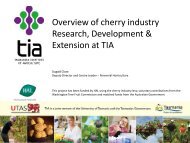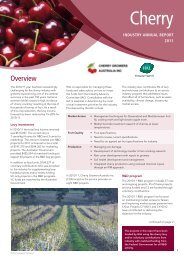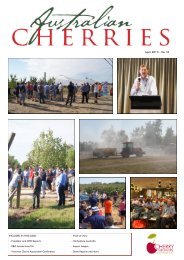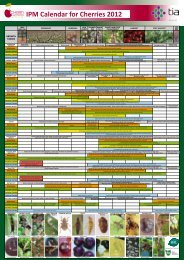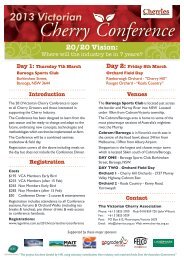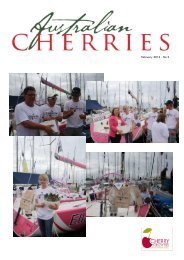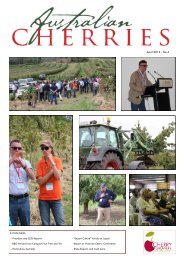annual industry report 08 • 09 - Horticulture Australia
annual industry report 08 • 09 - Horticulture Australia
annual industry report 08 • 09 - Horticulture Australia
Create successful ePaper yourself
Turn your PDF publications into a flip-book with our unique Google optimized e-Paper software.
Taking a new view of cherry cracking<br />
By better understanding how water<br />
enters the cherry, the costly problem<br />
of cherry cracking can be better<br />
understood and managed.<br />
Rain-induced cherry cracking has<br />
always been a major challenge<br />
to sweet cherry growers. The<br />
unpredictable nature of rainfall and<br />
limited strategies to combat the<br />
problem makes the management of<br />
cherry cracking difficult and costly.<br />
This project was initiated to further<br />
understand the process by which<br />
water enters cherries during and<br />
following rainfall. It has extended the<br />
current understanding of cracking by<br />
examining an alternative view of the<br />
underlying process.<br />
Different pathways exist by which<br />
water can enter the fruit, thereby<br />
causing it to crack. The propensity<br />
for cracking interacts with the time<br />
of rainfall, cherry variety, seasonal<br />
conditions and crop load.<br />
Cracks at the two ends of the fruit<br />
(apical and stem) have been shown to<br />
be caused by water moving directly<br />
across the skin of the cherry, whereas<br />
the large side cracks are caused by<br />
water moving from the soil via the<br />
internal system of the tree.<br />
Higher numbers of fruit per tree<br />
reduced the level of cracking, further<br />
confirming the alternative view of the<br />
importance of the hydraulic system<br />
of the whole tree to the cracking<br />
problem. Work over the last season<br />
has extended our understanding of<br />
the hydraulic system of the whole<br />
cherry tree and its link to cherry<br />
cracking.<br />
Simulated rainfall applied during the<br />
afternoon period induced higher levels<br />
of cracking – especially side cracks –<br />
than night or morning applications.<br />
Further work on the incidence of<br />
cracking has confirmed varietal<br />
differences in propensity to particular<br />
types of cracks, suggesting that varietal<br />
specific management strategies need to<br />
be considered in combating the problem.<br />
The increased understanding of the<br />
process of cherry cracking should permit<br />
better risk assessment and provide the<br />
potential for the development of effective<br />
integrative prevention strategies.<br />
The project will be completed later<br />
this year.<br />
Project CY06001<br />
For more information contact:<br />
Alistair Gracie, University of Tasmania<br />
T 03 6226 7468<br />
E a_gracie@postoffice.utas.edu.au<br />
8<br />
Development of an International Standard for<br />
Mobile Elevating Work Platforms<br />
This project is the final of a series to<br />
represent orchard grower’s interests<br />
in the development of standards<br />
for mobile elevating work platforms<br />
(MEWPs) used in orchards.<br />
The work has covered the operating<br />
and maintenance standard<br />
AS 2550.10 (published in 2006),<br />
the design standard AS 1418.10<br />
(expected to be published 20<strong>09</strong>), and<br />
the international design standard<br />
ISO/DIS 16653-3 which is currently<br />
in draft.<br />
Prior to this multi-<strong>industry</strong><br />
initiative, orchard growers were<br />
not represented on the standards<br />
committees. The standards<br />
therefore tended to cover the needs<br />
of industrial users and did not<br />
recognise important innovations<br />
necessary to ensure MEWPs could<br />
operate efficiently and safely in<br />
orchards.<br />
For example, an orchard MEWP operator<br />
may pick over 14,000 avocados in a<br />
shift repositioning the platform perhaps<br />
5,000 times. The controls needed to<br />
provide for this high-speed picking<br />
are quite different from those required<br />
for an industrial MEWP which may be<br />
repositioned less than 20 times in a shift.<br />
Similarly, orchard MEWPs are generally<br />
smaller than industrial counterparts and<br />
need to travel faster to ensure efficient<br />
operation.<br />
The omission of orchard grower input to<br />
the standards had left orchard MEWPs<br />
non-complying. Growers were at risk<br />
of dispute and prosecution from safety<br />
regulators and civil litigation in the event<br />
of an injury involving an orchard MEWP.<br />
The current and final part of the project<br />
has been to develop an international<br />
standard for orchard MEWPs. The<br />
international standards did not recognise<br />
orchard MEWPs and their special<br />
requirements. Courts have been known<br />
to reference higher-level standards in<br />
injury litigation and on that basis it was<br />
judged prudent to gain recognition at<br />
international level.<br />
A valuable outcome of the project is<br />
that a commentary has been included<br />
in AS 1418.10 covering the use of<br />
MEWPs in orchards. The document<br />
has been written with input by orchard<br />
MEWP manufacturers and users. As<br />
the only published document covering<br />
the subject it may serve to help<br />
growers and manufacturers explain<br />
why efficient orchard MEWPs must be<br />
different from MEWPs used in general<br />
<strong>industry</strong>.<br />
Project MT<strong>08</strong>013<br />
For more information contact:<br />
Keith Batten, Keith Batten &<br />
Associates<br />
T 0418 738 969<br />
E batten@bigpond.net.au



